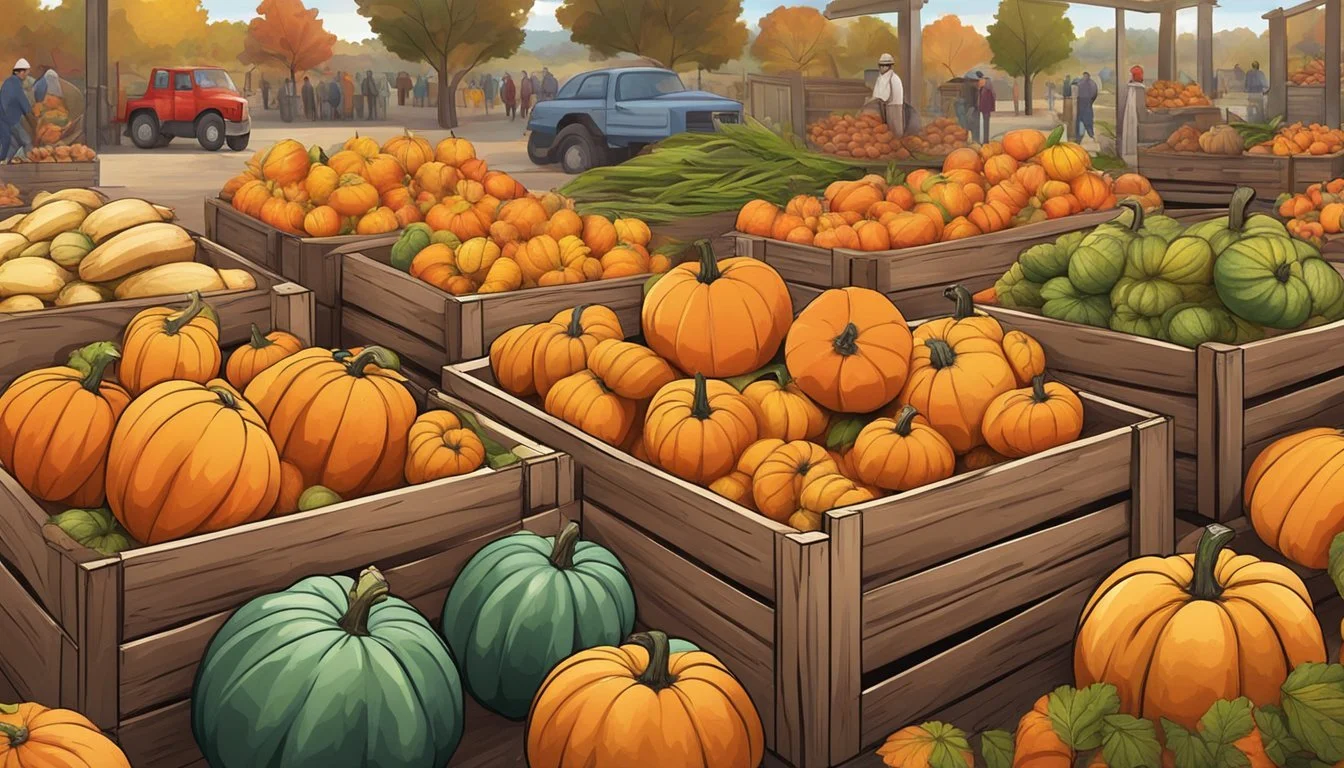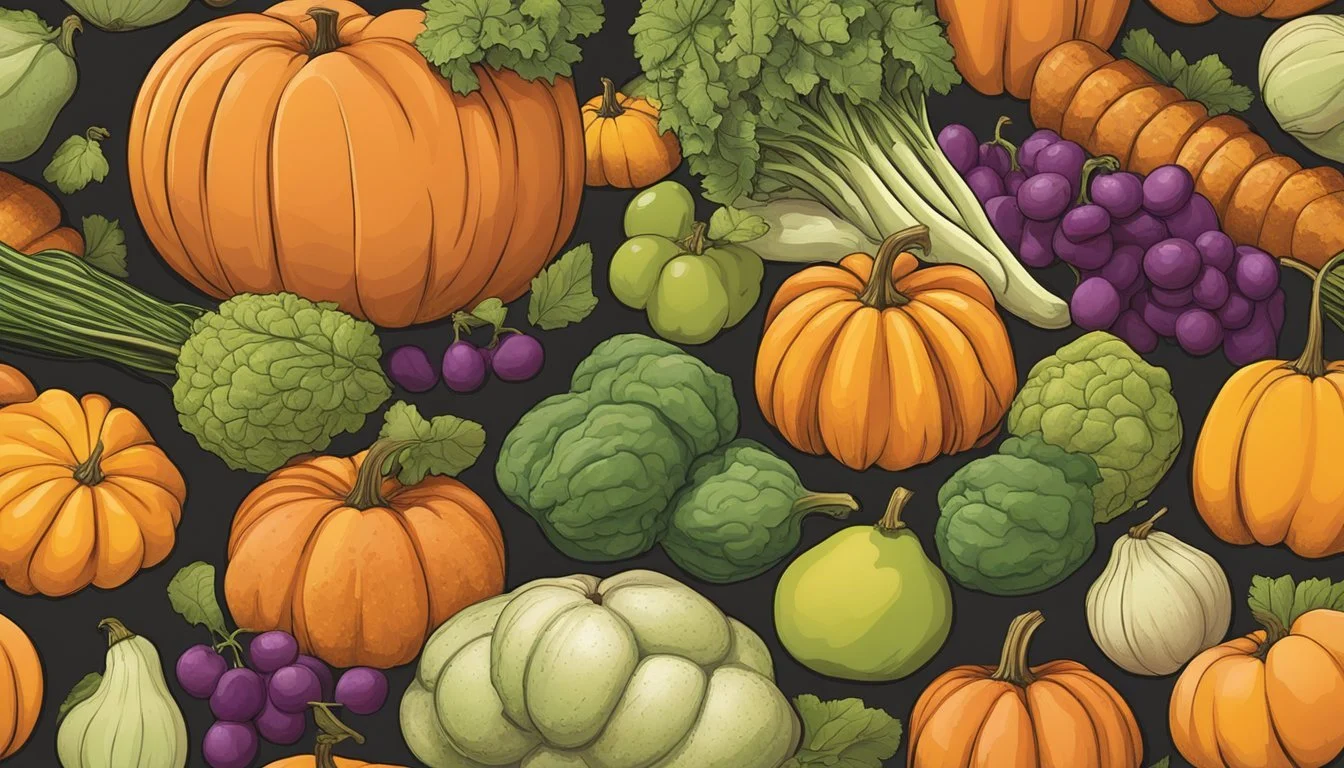Alabama Seasonal Fruit & Vegetables in October
Your Guide to Fresh Produce
This Article is Part of our Alabama Seasonal Fruit & Veg Calendar
October in Alabama brings a transition in the air, with cooler temperatures setting the perfect stage for a variety of fruits and vegetables to reach their peak. In this pivotal month, farmers and gardeners across the state are harvesting the last of summer's bounty while simultaneously welcoming the hearty crops that thrive in autumn's cooler climate. Seasonal eating not only supports the local economy but also ensures the highest quality and nutritional value of produce.
Alabama's October produce is diverse, ranging from the final flourish of warm-weather crops to the first hints of traditional fall vegetables. The state's rich soil and unique climate create optimal growing conditions for a range of produce. Strawberries, a cherished spring fruit, give way to the robust flavors of fall's offerings such as apples (how long do apples last?), which are crisp and abundant in this month, providing a versatile ingredient for both sweet and savory dishes.
Vegetable gardens and farms throughout Alabama are similarly abundant with produce during October. Green beans, okra, and sweet onions are just a few vegetables that residents can enjoy fresh from the field. The cooler weather also marks the emergence of various types of cabbages, including green, napa, red, and savoy, along with staples like beets (how long do beets last?), bell peppers, and eggplant. Planting activities may continue, with preparations for the next growth cycle already in motion as the state cycles through the richness of its agricultural calendar.
Fruits and Vegetables in Season
In October, Alabama's harvest brings a variety of fruits and vegetables to the table, each bursting with flavor and packed with nutrition ideal for fall recipes.
Apples
During this month, apple varieties such as Crispin, Braeburn, Granny Smith, Macoun, and Fuji are at their peak. Their crisp texture and diverse flavors make them perfect for both fresh eating and culinary creations, from salads with nuts and cheeses to classic apple pies.
Pumpkins
Pumpkins signal the full arrival of fall, with their rich, sweet flesh being a staple for both decorative and cooking purposes. Their versatility extends beyond pies into soups, roasts, and preserves, supplying significant dietary fiber and vitamin A.
Sweet Potatoes
These tubers exhibit a deep, earthy sweetness and are inherently nutritious, laden with vitamins A and C. Sweet potatoes (What wine goes well with sweet potatoes?) in Alabama are ready for harvest and can be baked, mashed, or used in heartwarming stews.
Greens
Collard, mustard (how long does mustard last?), and turnip greens flourish in the cooler temperatures of October, providing a bounty of leafy vegetables. They are commonly simmered down with savory ingredients to create a nutrient-rich side dish high in vitamins K and C.
Cauliflower
Cauliflower's (how long does cauliflower last?) subtle flavor becomes available in October. It's a versatile vegetable that can be roasted, steamed, or even used as a low-carb substitute in various dishes, offering a good source of vitamin K and fiber.
Beets
The cooler weather of Alabama's October is ideal for beets, which can be harvested for their earthy-flavored roots and nutrient-rich greens. They can be enjoyed roasted, pickled, or as part of a salad, providing antioxidants and folate.
Gardening Tips for October
October is a critical time in Alabama for gardeners to prepare for successful spring growth. Key activities this month include soil preparation, strategic planting, and timely pruning.
Soil Preparation
Gardeners should begin by testing their soil to determine its nutrient content and pH level, adjusting as needed to support optimal plant growth. Incorporation of organic matter, such as compost or well-rotted manure, enhances the soil structure and fertility. It's also time to renew mulch around shrubs to regulate soil temperature and moisture, as well as protect against weed growth.
Test soil: pH and nutrient levels
Incorporate organic matter: Compost or manure
Renew mulch: Around shrubs and beds
Planting
October is ideal for sowing certain fruit and vegetable seeds. For maximum growth, follow recommended planting depths and spacing.
Planting guide:
Fruits: Cool-season fruits; check local varieties suitable for fall planting.
Vegetables: Lettuce, cabbage, and other cool-season crops thrive in cooler temperatures.
Ensure proper depth and spacing as per specific crop requirements.
Pruning
Pruning in October serves to remove dead or diseased branches, promote healthier spring growth, and maintain desired plant shapes. Gardeners need to prune before freezing weather to facilitate plant health and prevent potential winter damage.
Remove: Dead or diseased wood
Maintain shape: Control plant growth and aesthetics
Prevent damage: Prune sensitive plants before the first freeze
Harvest Calendar
In October, the focus for harvesting in Alabama is on both the tail end of summer produce and the full swing of fall fruits and vegetables. This period is characterized by a variety of crops ready for picking.
Fruits
Apples: Various apples varieties such as Red Delicious, Golden Delicious, and Granny Smith are typically ripe.
Pumpkins: Not just for decoration, they are at their peak for flavor.
Figs: Late season figs are often still available.
Vegetables
Sweet Potatoes: A staple for fall, sweet potatoes are harvested before the first frost.
Greens: Mustard greens, collard greens, and turnip greens thrive in cooler temperatures.
Broccoli & Cauliflower: These vegetables prefer the cool fall days to mature.
Additionally, other crops like radishes and winter squash are also harvested during this month. Farmers often plant these crops earlier in the year so they can be harvested before the first frost of the approaching winter.
Category Harvest Dates Fruits Throughout October Vegetables Early to late October
The produce at this time is ideal for both fresh consumption and for storage, ensuring a supply of fall flavors even as the season winds down. It's a great time for consumers to visit local markets for the freshest seasonal produce.
Seasonal Recipes and Preparation
October in Alabama brings a bounty of seasonal fruits and vegetables that can be transformed into a variety of delicious and nutritious recipes. With an emphasis on the harvest's fresh flavors and nutritional benefits, here are some recipe ideas:
Pumpkin: Rich in vitamins A and C, pumpkin can be roasted for a simple side dish or pureed to make a creamy pumpkin soup.
Recipe idea: Pumpkin Pie – A classic dessert that highlights the natural sweetness and spice of pumpkin.
Apples: Apples offer versatility in the kitchen. They are not just nutritious, containing dietary fiber, but also lend themselves to both sweet and savory dishes.
Recipe suggestion: Apple Crisp – A warm dessert that accentuates the apple's natural flavor profile with a crisp, oat topping.
Squash Varieties: Butternut, acorn, and delicata squashes are in season and filled with nutrients like beta carotene.
Recommendation: Roasted Squash Salad – A colorful and flavorful dish that allows the squash to shine.
Greens (like chard): Greens thrive in the cooler weather and are packed with iron and vitamins.
Cooking idea: Sautéed Greens – A quick and easy way to enjoy the nutritious leaves, flavored with garlic and olive oil.
Root Vegetables (like parsnips): Root vegetables are hearty and provide essential nutrients like vitamin C and fiber.
Dish proposal: Parsnip Puree – A creamy, comforting alternative to mashed potatoes, highlighting the mild, sweet flavor of parsnips.
Each recipe celebrates the abundance of Alabama's October harvest, bringing the season's best to the table with taste and nutritional value in mind.
Importance of Seasonal Consumption
Consuming fruits and vegetables during their peak season has significant nutritional benefits. In-season produce tends to be fresher, as it is often harvested at the peak of ripeness when it is most nutrient-dense. For instance, nutrient content, such as vitamins and antioxidants, can be higher in fruits and vegetables picked during their natural growing season.
A focus on seasonal consumption also aligns with the freshest availability. As foods grown in their appropriate season require less human assistance and fewer resources, they can be brought to market more swiftly after harvest, ensuring a crisper, more flavorful experience.
Here's a look at the advantages of seasonal consumption:
Flavor: Vegetables and fruits picked at their peak naturally have more vibrant flavors.
Cost: When produce is in abundance, it's often less expensive due to decreased transportation and storage costs.
Sustainability: Seasonal eating supports local farming, which can reduce the carbon footprint associated with long-distance transportation.
Consumers benefit from integrating seasonal produce into their diets. Embracing Alabama's October harvests, which can include produce like pumpkins and sweet potatoes, provides an opportunity to enjoy foods at their best in terms of both taste and nutritional potential. Additionally, it is a way to support the community's economy and promote environmental sustainability.
Resources for Alabama Gardeners
Alabama gardeners have access to various resources that provide extensive knowledge and month-by-month guides to enhance their gardening experience. These include publications from Auburn University, a detailed Alabama Gardener's Calendar, and supportive social media communities.
Auburn University Publications
Auburn University's Extension System offers valuable publications regarding vegetable seasons in Alabama. The Alabama Cooperative Extension System provides a myriad of resources, one of which is a publication on mustard greens, cucumbers, tomatoes, and other vegetables that are in season. This publication is authored by Andre Luiz Biscaia Ribeiro da Silva, an Extension Specialist and Assistant Professor of Horticulture at Auburn University.
Alabama Gardener's Calendar
The Alabama Gardener's Calendar is an essential resource for planning monthly gardening activities. It covers not only vegetable planting guides but also tips for lawns, shrubs, annuals, and perennials. This calendar serves as a practical guide for fruit and nut trees and bulbs, roots, and tubers as well.
Social Media Communities
Gardeners in Alabama can connect with fellow enthusiasts and experts through social media platforms such as Facebook and Twitter. These communities offer a platform for sharing experiences, troubleshooting problems, and staying updated on local gardening events and news. They provide a sense of camaraderie and support for both novice and experienced gardeners.
Upcoming Gardening Activities
October in Alabama brings a shift in gardening activities as the state transitions from the warm harvest months to cooler temperatures. Gardeners should focus on indoor plantings for a continued harvest, soil testing to prepare for next year, and winter preparation to protect plants from the approaching frosts.
Indoor Plantings
During October, Alabama gardeners can begin indoor plantings of certain annuals and perennials. These can include:
Annuals: Pansies, snapdragons, and violas for indoor blooms.
Perennials: Start herb cuttings like rosemary and thyme to grow indoors.
Soil Testing
The importance of soil testing cannot be overstressed. In October, test the soil to determine amendments needed for the upcoming planting season. Key points include:
pH level: Should be between 6.0 and 7.0 for most lawns and shrubs.
Nutrient levels: Identify the need for fertilizers or organic matter.
Winter Preparation
Winter preparation involves several tasks to ensure the protection and health of various plants:
Frost: Monitor the weather closely and cover sensitive plants when frost warnings are issued.
Mulching:
Apply a layer of mulch to perennials, bulbs, roots, and tubers to protect them from the cold.
Utilize leaves, straw, or commercial mulch around shrubs and nut trees for insulation.
Lawn care: Reduce mowing frequency but ensure the lawn is clear of leaves to prevent fungal growth.
Remember that October in Alabama is a critical time to perform these activities to maintain a healthy and vibrant garden through the fall and into the next season.






